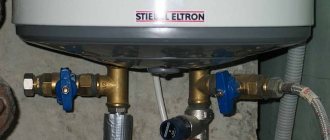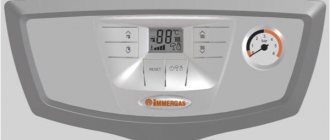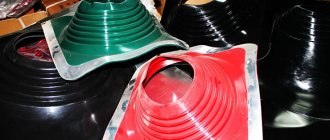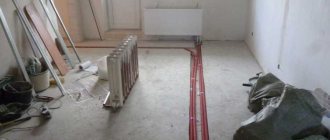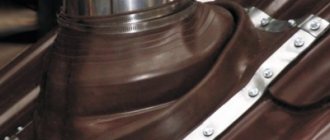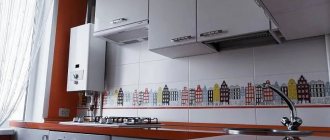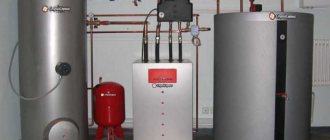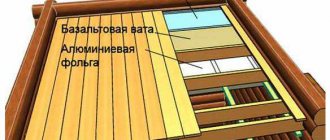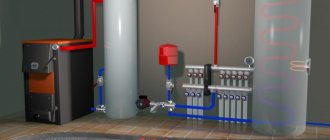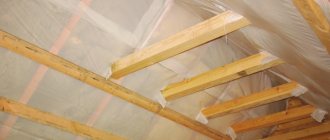Schemes for connecting heating elements to a three-phase network.
For inclusion in a three-phase electrical network, heating elements with an operating voltage of 220 and 380 V are used. Heaters with an operating voltage of 220 V are switched on according to the star
", and heaters with a voltage of 380 V are switched on according to the "
star
" and "
delta
" circuits.
3.1. Star connection diagrams.
Consider a star
, composed of three heaters.
to pin 2
of each heater.
Terminals 1
are connected together and form a common point, called
zero
or
neutral
, and this load connection circuit is called
three-wire
.
Three-wire switching on
The circuit is used when heaters or any other load are designed for an operating voltage of 380 V. The figure below shows a wiring diagram for three-wire connection of heaters to a three-phase electrical network, where the supply and shutdown of voltage is carried out by a three-pole circuit breaker.
In this circuit, the corresponding phases A
,
B
and
C
, and the left terminals are connected to
the zero point
. Between the zero point and the right terminals of the heaters, the voltage is 220 V.
In addition to the three-wire circuit, there is a four-wire circuit , which involves connecting a load with an operating voltage of 220 V to a three-phase network. With this connection, the zero point of the load is connected to the zero point of the voltage source.
In this circuit, the corresponding phase is supplied to the right terminals of the heaters, and the left terminals are connected to one point, which is connected to the zero bus
voltage source. Between the zero point and the heater terminals, the voltage is 220 V.
If it is necessary for the load to be completely disconnected from the electrical network, then “ 3+N”
"or "
3P+N
", in which all four power contacts are switched on and off.
3.2. Triangle connection diagrams.
When connecting in a triangle, the leads of the heaters are connected in series with each other. Let's consider the circuit for connecting three heaters: output 1
heater
No. 1
is connected to terminal
1
of heater
No. 2
;
pin 2
of heater
No. 2
is connected to pin
2
of heater
No. 3
;
pin 2
of heater
No. 1
is connected to pin
1
of heater
No. 3
.
As a result, we got three shoulders - “ a
”, “
b
”, “
c
”.
Now we apply a phase to each shoulder: to shoulder “ a
"phase
A
, to arm "
b
" phase
B
, and to arm "
c "
phase
C.
3.3. Scheme “heater - thermal relay - contactor”.
Let's look at an example of a temperature control circuit. This circuit is made up of a three-pole circuit breaker, a contactor, a thermal relay and three star-connected heaters.
Phases A
,
B
and
C
from the output terminals of the machine are supplied to the input of the power contacts of the contactor and are constantly on duty on them. The left terminals of the heating elements are connected to the output power contacts of the contactor, and the right terminals are connected together and form a zero point connected to the zero bus.
From the output terminal of the machine, phase A
is supplied to the power terminal of thermal relay
A1
and is transferred by a jumper to the left output of contact
K1
and is constantly on duty on it.
The right terminal of contact K1
is connected to terminal
A1
of the contactor coil.
Zero N
from the zero bus it goes to output
A2
of the contactor coil and is transferred by a jumper to the supply terminal
A2
of the thermal relay.
The temperature sensor is connected to terminals T1
and
T2
of the thermal relay.
In the initial state, when the ambient temperature is above the set value, relay contact K1
is open, the contactor is de-energized and its power contacts are open.
When the temperature drops below the set value, a signal comes from the sensor and the relay closes contact K1
.
Through closed contact K1,
phase
A
is supplied to terminal
A1
of the contactor coil, the contactor is activated and its power contacts are closed.
Phases A
,
B
and
C
are supplied to the corresponding terminals of the heaters and the heaters begin to heat up.
When the set temperature is reached, a signal comes from the sensor again and the relay gives a command to open contact K1
.
Contact K1
opens and the supply of phase
A
to terminal
A1
of the contactor coil is stopped. The power contacts open and the voltage supply to the heaters is stopped.
The next version of the heater switching circuit differs only in the use of a three-pole circuit breaker with three phase and zero power contacts that can be switched off.
How to connect an electric heating element to a 380 and 220 Volt boiler
Theory
What is a heating element in an electric boiler? From the point of view of electrical engineering, this is an active resistance that generates heat when an electric current passes through it.
In appearance, a single heating element looks like a bent or curled tube. Spirals can be of very different shapes, but the connection principle is the same; a single heating element has two contacts for connection.
When connecting a single heating element to the supply voltage, we simply need to connect its terminals to the power supply. If the heating element is designed for 220 Volts, then we connect it to the phase and working zero. If the heating element is 380 Volt, then connect the heating element to two phases.
But this is a single heating element, which we can see in an electric kettle, but not in an electric boiler. The heating element of a heating boiler is three single heating elements mounted on a single platform (flange) with contacts located on it.
The most common boiler heating element consists of three single heating elements mounted on a common flange. On the flange there are 6 (six) contacts of the electric heating element of the boiler for connection. There are boilers with a large number of single heating elements, for example, like this:
Boiler heating element connection diagrams
Option 1. Connection diagram to a single-phase network
Typically, three single heating elements in such a design are placed so that the contacts from different heating elements are located opposite each other.
To connect a heating element to 220 Volts, you need to connect three contacts from different single spirals with a jumper and connect them to the working zero.
The three remaining contacts also need to be connected and connected to the working phase. This will ensure that all heating elements are turned on simultaneously for heating when power is applied.
class="eliadunit">
However, the connection is not made directly this way, and for every second contact the heating element is connected to a phase after its own machine or, what is done more often, it is connected from its own control line (automation).
Option 2. Three-phase connection
If we look at the heating elements for boilers sold, we will see that almost all of them are labeled as 220/380 Volt heating elements.
If you have this version of the heating element, and you have the opportunity to connect to a three-phase power supply of 220 Volts or 380 Volts, then you need to use connection diagrams called “star” and “delta”.
According to the “star” circuit of 220 Volts, three phases, you need to connect the three contacts of single heating elements with a perm and connect them to the working zero. Apply to the second free contacts via a phase wire. Each single heating element will operate from 220 Volts, independently of each other.
According to the “triangle” circuit of 380 Volts, you need to connect contacts 1-6, 2-3, 4-5 with jumpers, for single heating elements 1-2.3-4.5-6 and supply phase wires to them. Each single heating element will operate at 380 Volts, independently of each other.
Conclusion
As you can see, electric heating elements are easy to connect and connecting the heating element itself does not cause problems. A more complex issue is connecting the automation and temperature sensor. More on this in the following articles.
©Obotoplenii.ru
More articles
class="eliadunit">
obotoplenii.ru
Star connections
As an example, let's take a star connection with three electric heaters. In this way, you can connect dry heating elements with four terminal bolts and heating elements blocks.
Every second output of the heating element is connected to the corresponding phase. The first terminals are connected together and form a common point, defined as zero or neutral. The connected load in this case is considered to be three-wire.
The three-wire connection is designed for an operating voltage of 380 Volts. Below we will consider the diagram for connecting a tubular heater to a three-phase network
. In this case, the voltage is switched on and off automatically using three-pole switches.
In the above diagram you can see that the heater terminals on the right are connected to phases A, B, C. The terminals on the left are connected at a common neutral point. The operating voltage between the terminals on the right and the neutral point is 220 Volts.
In addition to the three-wire connection, you can connect to the network using a four-wire star circuit. In this case, the heaters are connected to a three-phase network, the voltage of which is 220 Volts. The zero point of the load is connected to the neutral point of the power source.
The presented diagram shows the connection of the right terminals of the tubular heating elements to the corresponding phases, while the left ones are closed at one point connected to the neutral bus of the power source. Between zero and the heater terminals the voltage is 220 Volts.
If you need to completely disconnect the load from the electrical network, “3+N” or “3P+N” switches are used, which operate in automatic mode. With the help of such machines, it is possible to completely transfer all power contacts to an automated operating mode. For a clear practical application of the “star” circuit, let’s consider connecting the electric heaters of the boiler.
Boiler heating element connection diagrams
Option 1. Connection diagram to a single-phase network
Typically, three single heating elements in such a design are placed so that the contacts from different heating elements are located opposite each other.
To connect a heating element to 220 Volts, you need to connect three contacts from different single spirals with a jumper and connect them to the working zero.
The three remaining contacts also need to be connected and connected to the working phase. This will ensure that all heating elements are turned on simultaneously for heating when power is applied.
class="eliadunit">
However, the connection is not made directly this way, and for every second contact the heating element is connected to a phase after its own machine or, what is done more often, it is connected from its own control line (automation).
Option 2. Three-phase connection
If we look at the heating elements for boilers sold, we will see that almost all of them are labeled as 220/380 Volt heating elements.
If you have this version of the heating element, and you have the opportunity to connect to a three-phase power supply of 220 Volts or 380 Volts, then you need to use connection diagrams called “star” and “delta”.
According to the "star" scheme
220 Volt three phases, you need to connect the three contacts of single heating elements with a perm and connect them to the working zero. Apply to the second free contacts via a phase wire. Each single heating element will operate from 220 Volts, independently of each other.
According to the "triangle" pattern
380 Volts, you need to connect contacts 1-6, 2-3, 4-5 with jumpers, for single heating elements 1-2.3-4.5-6 and supply phase wires to them. Each single heating element will operate at 380 Volts, independently of each other.
We continue to get acquainted with tubular electric heaters
(
TEN
).
In the first part we looked at, and in this part we will consider the inclusion of heaters in a three-phase network
.
CONNECTING ELECTRIC BOILER TENS
For an electric boiler, you can choose several connection options, but in this case we will consider connecting dry heating elements to a three-phase network with a voltage of 220 Volts of the “star” type. Due to the high power output of dry tube heaters, it is important that the supply wires are connected to them securely. Therefore, it is recommended to strictly adhere to the diagram for connecting wires to the terminals of the heating element according to the instructions.
When connecting phase wires to the terminals of electric heaters, you should first screw on the M4 nut. After this, you need to apply the washer and put on the tip-ring of the supply wire. Next, the washer is applied again, and a spring washer-grower is placed on top of it. All this is clamped with an M4 nut.
The wire that will be connected to the neutral phase is tightened with an M8 bolt. It will be located in the jumper between the contacts of the heater holes.
After connecting the wires, ground the heater body and the heating element connection wires. Typically, grounding boilers have a bolt on the left side of the electric heater block, to which the grounding conductor should be connected.
As a protective grounding conductor, you can use a separate conductor of the additional potential equalization system or take it from the grounding terminal of the control unit.
After the above work, we can assume that the connection of the heating element of the electric boiler is complete. Now all that remains is to install the protection casing on the heat exchanger block.
sensors are used to control water and air temperatures.
. On the main panel of the electric boiler control unit there are two marked regulators - “air” and “water”. Each of the regulators has its own graduation with a digital code, which indicates the temperature measured in Celsius. Thanks to such regulators, you can easily set the required thermal values of the coolant. The regulator operates on the principle of adjustment: when the temperature of the electric boiler reaches the values that were set in the options, the heating element will stop heating, and when the values drop below the required level, the heating devices will start working again.
Thus, it is possible to automate the operation of the electric boiler. The operator just needs to set the values of the required indicators, and further work will be carried out automatically. The heat in the room will be maintained at the desired level without human intervention.
Temperature sensors greatly facilitate the operation of the electric boiler. The water temperature control sensor is located directly in the heat exchanger in a special seat. Alternatively, you can install it yourself by attaching it to the heating pipe.
The sensor that determines the air temperature works in a similar way. It is installed in a room to measure the general temperature. The electric boiler will heat the coolant until the air in the room reaches the required temperature values.
Connecting heaters according to the STAR scheme for an electric boiler
In electric heating boilers, heating elements can be connected in various ways, but to demonstrate the STAR-type connection diagram, we will describe the option of installing dry heating elements to a 3-phase power supply network with a voltage of 220V.
The high power of dry water heating elements imposes certain requirements on the quality of connections. The reliability of the connections must be ensured by high quality heat-resistant wires and strict compliance of all actions with the diagram described in the instructions.
The first thing to do is to screw on the M4 nut when connecting the phase drives. Next, you need to apply the washer and install the ring terminal of the power wire. The next step is to apply another similar washer, on top of which another special Grover spring washer is placed. And all this needs to be securely fixed with an M4 nut.
The wires that lead to the neutral phase are secured using an M8 bolt. The neutral wire must be placed in a jumper, which is located between the contacts of the heating element holes.
Be sure to ground the body of the heating element and power wires after connecting all the wires to the supply and neutral contacts of the heating element. In most cases, in standard electric boilers, the grounding bolt is located on the left side near the block with heating elements. We must connect the grounding wire to it.
After connecting the wires, ground the heater body and the heating element connection wires. Typically, grounding boilers have a bolt on the left side of the electric heater block, to which the grounding conductor should be connected.
You can use either a separate potential equation wire or a wire from the grounding terminal block of the control unit for grounding.
You can clearly see all of the above described in the figure below in the form of a diagram and photo of connecting the heating element.
If you have done everything in strict accordance with the instructions, the connection of the heating element of the electric boiler can be considered complete. All that remains is to return the protective casing to the heating unit.
In electric boilers, heating is controlled based on data from temperature sensors. Thermostatic devices are located on the main control panel of the boiler. The thermostat will receive data on the temperature of the heating element and the temperature of the coolant. Based on these readings and the settings set on the thermostat, a decision is made automatically to supply or turn off power to the heating elements. While the temperature is below the set one, power will be supplied and the heating elements will produce heating, and when the threshold value is reached or exceeded, the power will be turned off and the heating elements will stop heating. When it cools down to the lower threshold, the heating element will turn on again.
The thermostat allows a person to set the temperature (upper and lower thresholds) just once, and then the electric boiler will operate automatically, and the temperature will be maintained at the desired level.
READ 019443 gntx 101 mirror how to connect
There is an option to use thermostats with several types of temperature sensors, which will not only control the heating of the heating element itself, but also the air temperature in the room. To do this, the temperature sensor must be installed at a distance from the boiler and coolant.
Delta connection
When connecting according to the “triangle” scheme, the leads of the tubular heater are connected in alternate order. A connection diagram of this type means that: pin number 1 of the first heater will be connected to pin number 1 of the second heater; pin No. 2 of the second heating element will be connected to pin No. 2 of the third heater; from the first heater, terminal No. 2 will be connected to terminal No. 1 of the third heating element. If you follow this pattern, you should end up with three arms - “a”, “b”, “c”. Each arm will receive its own phase:
The power of the heaters and their temperature supply depend on the heating element connection diagram
When choosing a heater, the buyer first of all pays attention to its power. Technical practice shows that with a constant connection to a certain network, when transformers are not used, power indicators depend only on the electrical resistance of the resistive element, which is located in the heating device itself. The dependence is defined by the formula:
where P is power,
U is the voltage between the ends of the heating element,
I is the current flowing through the resistive element.
Due to the fact that the current passing through the spiral depends only on the voltage applied to the ends and the intrinsic electrical resistance (R) of a particular section of the spiral, the formula can be simplified:
From this we can conclude that under constant voltage conditions, power will increase only when the resistance drops.
The electrical resistance of most heating devices directly depends on the temperature output of the heating element itself. But, the resistance will change slightly within a few hundred degrees. It is worth understanding that with silicon carbide heaters the situation will be completely different. Since in them the function of a heating element is performed by a non-metallic rod, the resistance here will not change in a linear order. The resistance of such devices can be in the range of 0.5...5 Ohms, which will not allow direct connection of the heating device to a 220 Volt network, much less 380 Volt. By technical standards, silicon carbide heaters can be connected to a standard network if they are assembled in a daisy chain. But. It is worth noting that this technique is ineffective if it is necessary to accurately control the power and adjust a certain oven temperature. The best way is considered to be connecting electric heaters to the network using laboratory controlled autotransformers or standard statistical electromagnetic devices.
There are heaters that are manufactured directly for a three-phase network, for example, block heating elements or W-shaped silicon carbide heaters. The method of connecting them depends on the calculated voltage in a star or delta circuit. When connecting according to the “triangle” scheme, it means connecting three heating units whose resistances are equal and each will be supplied with a voltage of 380 Volts. The “star” circuit with the presence of a neutral wire is described in detail above and is intended to supply 220 Volts to each consumer.
The neutral wire is necessary to connect consumers with different electrical resistances
Pickup: Moscow, st. Molodogvardeyskaya, 57
We deliver orders throughout Russia and the CIS:
Delivery by Transport Company.
Delivery by Russian Post – 400 rubles.
Delivery by courier in Moscow – 450 rubles.
We value our clients! It's a pleasure to work with us!
Different types of tubular electric heaters (TEHs) can be connected to single-phase and three-phase networks. The electric heater can be connected to a three-phase network using one of two main schemes - “star” or “delta”. To distribute the load evenly in each phase, the number of heating elements must be a multiple of three.
For three-phase networks, heaters are used whose operating voltage is rated at 220 and 380 Volts.
Electrical appliances with an operating voltage of 220 Volts are connected according to the “star” circuit, and heaters with a voltage of 380 Volts are connected to the network according to the “star” and “delta” circuits.
Device and connection diagrams of heating elements | For home, for family
Room thermostats can be divided by device, by method of device and by functionality.
Based on their technical design, room thermostats can be divided into 3 types:
- Electromechanical.
- Electronic.
- Mechanical.
According to the method of installation, room thermostats are divided into two types:
- Wireless thermostats. Using periodic signals, communications between the executive unit and the controller are carried out. Wireless thermostats have a big advantage: there is no need to make holes for wires. But there is also a small drawback: the signal power is reduced due to reinforced concrete walls.
- Wired thermostats. Contacts between blocks are maintained using wires. Such a thermostat can transmit data over a distance of more than 50 meters. The power source can be a household electrical network.
Based on functionality, the following types of room thermostats can be distinguished:
- Programmable thermostats. They can set the desired regime for several days in advance.
- Simple thermostats. They only maintain the required temperature.
- Room thermostats cannot create a harmful electromagnetic field. They only transmit a small impulse.
How to connect a thermostat to an infrared heater
Electrical wiring can be open or hidden.
Is it possible to use one thermostat in several rooms?
When installing a thermostat, it is necessary to take into account that the set temperature will be maintained only in the place where the sensor is located. Cables laid in several rooms must be connected in parallel, as when one heating cable to the thermostat
You should not use one thermostat when the operating conditions of the premises are different (bathroom and kitchen), and also when the rooms have different heat loss rates (room and balcony).
Choosing an electric boiler for your home
To choose the right electric boiler for heating your home, you need to consider many factors. including the material and thickness of the walls, glazing area, outdoor air temperature in winter in your region, ceiling height and many others.
Often, such calculations are entrusted to specialists who make a home heating project that takes into account all the necessary characteristics of the system, including the type and power of the electric boiler; often they even offer a specific model or several to choose from.
When independently choosing the required power of an electric boiler for heating, it is usually customary to use the following formula: 1 kW of power is required to heat 10 sq.m. Houses.
The rule is relevant for single-circuit boilers used only for heating rooms, but if there are two circuits, one of which is used to heat water in the hot water supply system, the calculation must be changed, the same should be done if the ceiling height is higher than the standard 2.5-2.7 m and in some other cases.
So, in our example, the area of the house is 120 sq.m. Therefore, an electric boiler with a capacity of 12 kW was chosen . model ZOTA - 12 series "Econom".
After all the theoretical calculations, we will determine whether this boiler is suitable for the permitted (allocated) power for the house. For us it is 15 kW, with a three-phase input, so a 12 kW boiler is suitable for us in terms of power.
Of course, if the electric boiler operates at its maximum capabilities, only 3 kW of the permitted amount will remain for the remaining consumers of the house, which is quite small. But since the boiler will be a backup one and will only turn on when the main gas boiler is faulty, this decision was made acceptable.
Flaws
Fragility is the main drawback of heating elements for heating with a thermostat.
Firstly, the tubular heater itself interacts with salts dissolved in water. As a result, scale grows on the tube, which leads not only to a decrease in efficiency, but also to damage to the heater. As a means of protection against plaque, some models install an additional rod - a magnesium anode.
Since magnesium is a chemically more active substance, salts preferentially interact with it, and the heating element is provided with protection against scale. And again, the disadvantage is that the protection rod slowly decomposes in a chemical reaction and eventually requires replacement.
And although replacing the anode is not a complicated process at all, which, like automation, does not require disassembling the entire structure, the inconvenience is the need to constantly monitor the presence of the reagent.
Inserting heating elements into the home heating system
If you want to replace or find a backup heat source for your solid fuel boiler, such as, for example, Don, Cooper, Evan, Breneram Aquaten or Teplodar, this option is perfect because it is not very labor-intensive and financially expensive.
When carrying out such a procedure, observe safety measures, since any activities using electrical energy are extremely unsafe.
Let's take a closer look at how to connect the heating elements on the boiler. When using it as a backup heating method, be aware of changes in pressure level; it is recommended to use a pump to equalize it.
Let's look at how to install such a device step by step:
- You need to check the direction of the thread in the pipe and measure its diameter.
- Drain the coolant.
- Check the level of the radiator, since at the slightest inclination there is a high probability of air pockets accumulating. Air lock in the heating radiator
- Install the heating element into the pipe. To ensure that the hole is sealed, use the gaskets that come with the kit; if they are not available, make them.
- Connect the heating element and thermostat to the radiator.
- If you have not previously installed a Mayevsky faucet, install it. Because it will be necessary to bleed air from the system.
Then fill the system with liquid, using the Mayevsky tap to release the accumulated air. Using a tester, check that the heating element is isolated from the battery to avoid electric shock; if a breakdown is still present, check the serviceability of the heating element. If its insulation is broken, it needs to be changed. Then perform the installation again.
Connection diagram of an electric boiler to a 380 V three-phase electrical network
The general electrical diagram for connecting a 380 V electric boiler is as follows:
As you can see, the line is protected by a three-phase residual current circuit breaker; grounding is necessarily connected to the boiler body.
As usual, according to tradition, I am posting a connection diagram for a three-phase electric boiler with a combination of an automatic switch (AB) plus a residual current device (RCD) in a circuit, which is often cheaper and more accessible than Diff. machine.
It is convenient to select protective automatic ratings and cable cross-sections for three-phase electric boilers of various capacities using the following table:
In three-phase electric boilers, three heating elements are usually installed at once, sometimes more. Moreover, in almost all household boilers, each of the tubular electric heaters is designed for a voltage of 220 V and is connected as follows:
This is the so-called star connection. For this case, the neutral conductor is connected to the boiler.
The heating elements themselves are connected to the network as follows: one end of each of the tubular electric heaters is connected by a jumper, the remaining three free phases are alternately connected: L1, L2 and L3.
If your boiler has heating elements designed for a voltage of 380 V, their connection diagram is completely different and it looks like this:
This connection of the heating element of an electric boiler is called a “triangle” and at the same voltage of 380 V, as in the previous “Star” method, the boiler power increases significantly. In this case, a neutral conductor is not required, only phase wires are connected, and the electrical connection diagram looks like this:
Do not deviate from the connection diagrams permitted for your electric boiler. if there are heating elements for 220V with a three-phase connection, do not convert the circuit to a “triangle”. As you understand, theoretically you can reconnect them and get a voltage of 380 V on the heating element, respectively, increasing their power, but in this case they will most likely simply burn out.
Star connections.
For example, let’s imagine a “star” circuit, which is made up of three electric heaters.
The second output (2) of each of the heaters is supplied with the corresponding phase. The first terminals (1) of the heating elements are connected together with the simultaneous formation of a common point, which is called zero or neutral. This type of load connection is a three-wire one.
a three-wire connection at an operating voltage of 380 Volts. Below we propose to consider the installation diagram of a three-wire connection of heating elements into a three-phase electrical network. In this case, the supply and shutdown of voltage occurs thanks to three-pole circuit breakers.
In the presented diagram it can be seen that the terminals located on the right side of the electric heaters are connected to phases A, B and C, and the terminals located on the left are connected at the zero point. Between the terminals on the right and the zero point, the operating voltage is 220 Volts.
In addition to the described circuit, you can also use a four-wire one . When connecting using a four-wire circuit, it is assumed that a three-phase load with a voltage of 220 Volts is connected to the network. In this case, the inclusion of the zero point of the load is connected to the zero point of the power source.
Two ways to connect heating elements to three phases.
“Three-phase” used to be something not very necessary and understandable for the common man, but in our time it has become a necessity for a private home. It is needed primarily for heating with electricity. Since an electric boiler has a high power (in most cases more than 6 kW), when using one phase you will need to install cables with a large cross-section of conductors. And this will be expensive, especially if the cable cores are made of copper. In a three-phase network, the cross-sections of the conductors will be noticeably smaller, for this reason most modern electric boilers are connected to a “three-phase” system. Now let's talk about the basic schemes for connecting heating elements to such a network.
Star.
This method is used if the heating element is designed for 220 V. In addition, the “star” requires that the neutral wire be connected from the panel. For clarification, consider the following figure:
In this case, instead of two jumpers there will be one. And it will be connected to zero, and the three remaining free ends will be connected to the corresponding phases. If you look at the block nut from above, it will all look like this:
Triangle.
This method is used to connect heating elements designed for 380 V. If you suddenly decide to install heating elements designed for 220 V in a “triangle”, they will simply burn out. Don't miss this important moment. The main difference between a “triangle” and a “star” is the absence of a neutral conductor. There are only 3 phases and nothing more. To better understand what we are talking about, look below:
In the picture everything looks simple and clear, but if you start connecting the contacts on the block nut, you will get the following:
It looks a little complicated, but in fact it is no different from the top picture. Colored lines and numbers here indicate the phases, and letters indicate the heating elements of the block.
Delta connection
With a delta connection, the leads of the electric heaters are connected to each other in series order. According to the connection diagram of three tubular electric heaters, the connection is carried out in the following order: the first terminal of the heater No. 1 is connected to the first terminal of the heating element No. 2; the second terminal of device No. 2 is connected to the second terminal of device No. 3; the second terminal of heater No. 1 is connected to the first terminal of device No. 3. As a result of this connection, you should get three arms - “a”, “b”, “c”.
Then the corresponding phase is supplied to each arm: to arm “a” phase A, to arm “b” phase B, and to arm “c” phase C.
Laws that apply when connecting heaters of the “triangle” type:
About electric boilers
A classic electric heating boiler, one might say a default boiler, the type of which is not specified, is considered to be electric boilers with heating elements.
TEN is an abbreviation for tubular electric heater. The analogue you see in an electric kettle with a spiral.
Depending on the number of heating elements in the boiler, their power changes. Since heating elements are often standard, the power of electric boilers from different manufacturers is also standard. This is 6/9/12/14/18/21/24/28 kW.
It is worth noting that the concept of an electric boiler is much broader than just heating element boilers. Induction and electrode boilers, which are also electric, have become widespread.
Electrical installation in a three-phase network
The diagram for connecting an electric boiler to a three-phase network is more complex, but even a beginner can do it.
The three phases must be connected as follows:
Please pay attention to the following nuances:
- Each water heater comes with a technical passport, which must indicate the manufacturer’s recommended wiring diagram for the electric boiler. Be guided only by this document in your case, because... The examples provided on the Internet may not always be suitable for your heating system.
- Be sure to protect the boiler and... These devices will prevent overload of the unit, short circuit and current leakage in the electrical network.
- The wiring must be grounded.
For your attention, a visual project of electric heating in a two-story dacha using a boiler:
Customs Union. Declaration of Conformity No. TS RU D-RU.AV98.V.00706 Valid from 12/30/2014. until December 25, 2019 Manufactured according to TU 3443-009-49110786-2002. Complies with the requirements of the technical regulations of the Customs Union TR CU 004/2011
Connection diagrams for heating elements (single-phase network)
Tubular electric heaters (TEHs), like other consumers of electricity, are connected to both single-phase and three-phase networks.
When connecting more than one heating element to a single-phase network (1 “phase” and “zero”), parallel, serial or combined connection schemes are used.
When connecting in parallel, the following basic laws apply:
- The voltage on each heating element is constant and equal to the network voltage;
- If one of the heating elements fails, the others continue to work;
- The total power of the assembly is the sum of the powers of all heating elements installed in parallel;
- If heating elements of different power are installed in parallel, then the total power is calculated using the formula: P total =U 2 /R total, where P total is the total power, U is the voltage, R total is the total resistance of the assembly. The total resistance of the assembly Rtotal is calculated by the formula: 1/Rtot =1/R 1 +1/R 2 +1/R 3 .
When connecting in series, the following basic laws apply:
- The total resistance of the assembly is the sum of the resistances of all heating elements installed in series;
- If heating elements of the same resistance are installed in series, then the voltage on each heating element is equal to the total network voltage divided by the number of heating elements in the assembly. In other words: U total =U 1 +U 2 +U 3.
- The total power of the heating element assembly is calculated by the formula P total =U total 2 /R total, where P total is the total power, U total is the total network voltage, R total is the total resistance of the heating element assembly. The total resistance of the assembly Rtot is calculated by the formula: Rtot =R 1 +R 2 +R 3.
- When one heating element fails, the common circuit breaks and the remaining heating elements also stop working.
When connecting a heating element in a combined manner, the circuit should be divided into several sections (A and B), for which the laws of either parallel (A) or series (B) connection will apply, respectively.
The voltage value in all diagrams is indicated when connected to the network - 220V.
Connection diagrams for heating elements (three-phase network)
Tubular electric heaters (TEHs), like other consumers of electricity, are connected to both single-phase and three-phase networks. When connecting to a three-phase network (3 “phases” and “zero”), two main connection diagrams are used (“star” and “delta”). In order to distribute the load evenly across phases, the number of connected heating elements should be selected as a multiple of 3.
1. Connection of heating elements - “star”
Basic laws that apply when connecting heating elements with a “star”:
- Between any “phase” and “zero” there is always 220V!
- In each branch of the “star” you can connect several heating elements connected to each other in series or in parallel (see connection diagrams in a single-phase network).
- The power of each branch of the “star” should be the same.
2. Connection of heating elements - “triangle”
Basic laws that apply when connecting heating elements with a “triangle”:
- Between any two “phases” there is always 380V!
- In each branch of the “triangle” you can connect several heating elements connected to each other in series or in parallel (see connection diagrams in a single-phase network).
- The power of each branch of the “triangle” should be the same.
- The total power of the connection is the sum of the powers of the three branches.
The voltage value in all diagrams is indicated when connected to a three-phase network - 380V.
. Tubular electric heaters
(
TEN
) are designed to convert electrical energy into heat.
They are used as a basis
in heating devices (devices) for industrial and household purposes that heat various media by convection, thermal conductivity or radiation. Tubular heaters can be placed directly in the heated environment, so their scope of application is quite diverse: from irons and kettles to furnaces and reactors.
The heating element is an electric heating element made of a thin-walled metal tube (sheath), the material for which is copper, brass, stainless and carbon steel. Inside the tube there is a spiral of nichrome wire, which has a high electrical resistivity. The ends of the spiral are connected to metal leads with which the heater is connected to the supply voltage.
The spiral is insulated from the walls of the tube by a compressed electrically insulating filler, which serves to remove thermal energy from the spiral and securely fixes it in the center of the tube along its entire length. Fused magnesium oxide, corundum or quartz sand is used as filler. To protect the filler from the penetration of moisture from the environment, the ends of the heating element are sealed with thermal and moisture-resistant varnish.
The heater leads are insulated from the walls of the tube and rigidly fixed with ceramic insulators. The supply wires are connected to the threaded ends of the terminals using nuts and washers.
The heating element works as follows: when an electric current passes through a spiral, it heats up and heats the filler and the walls of the tube, through which heat is radiated into the environment.
fins are used to increase heat transfer from heating elements.
, made of material with good thermal conductivity. As a rule, corrugated steel tape is used for fins, wound in a spiral on the outer shell of the heating element.
The use of such a design solution helps to reduce the overall dimensions and current load of the heater.
Electric boiler connection diagram
The general connection diagram for an electric boiler with heating elements is nothing more than a diagram for connecting one or more heating elements to the power supply.
To understand and understand the principle of connecting a heating element boiler, let’s look at the heating element.
In the photo you see the simplest heating element, consisting of one heating tube. As a result, such a heating element has only two contacts for connection. This heating element is connected directly. One contact per phase (usually 220 Volts), the second contact to working zero.
The power of such heating elements is small and they are not used in heating boilers. Their prerogative is kettles or washing machines, dishwashers.
In electric boilers, heating elements are “curled” from two, often three, tubes. The heating element for the boiler looks like this.
As you can see, such heating elements already have 6 (six) contacts for connection and this is the simplest option. The task of connecting the heating element of the boiler is to correctly connect the six contacts of the heating element to connect it to the power supply.
There is nothing complicated about this if you recall two classic connection diagrams from the electrical engineering course. You've probably heard of them, these are circuits called "star" and "triangle". I wrote about them in some detail in the article How a low-voltage consumer of 380 Volts receives electricity.
I will describe these schemes in simple language. So, we have 6 contacts divided into pairs. Only three pairs.
- The “star” circuit involves connecting one contact from three pairs and connecting it to the working “zero”. The remaining contacts of the heating element pairs are connected to phases L1, L2, L3 if the power is 380 V, or they are also connected and connected to phase L if the power is 220 V.
- According to the “triangle” circuit, all pairs of contacts are connected in series and connected to three phases of 380 V.
Connection diagram of the electric boiler to the electrical network
An electric boiler installed in a heating system is often the most energy-intensive device in the entire house; moreover, its power consumption is often higher than that of all other electrical equipment in the premises combined.
And this is not surprising, because even the unspoken rule for choosing a boiler for a home states that 1 kW (kilowatt) of power is required to heat 10 square meters of a house. Following it, to heat a relatively small (by modern standards) house of 100 sq.m., you will need an electric boiler with a capacity of 10 kW.
Of course, this is a general rule; in real conditions, when choosing the power of a boiler, many factors are taken into account, but in general, the rule reflects the approximate, average requirements for the boiler correctly.
Therefore, for such a “gluttonous” consumer of electricity as an electric boiler, on whose stable operation in winter a lot depends, it is important to make the correct electrical wiring, select reliable automatic protection and make the connection correctly.
To better understand the principle of connecting a boiler, you need to know what it usually consists of and how it works. We will talk about the most common heating element boilers, the heart of which is Tubular Electric Heaters (TEH).
An electric current passing through the heating element heats it up; this process is controlled by an electronic unit that monitors important indicators of the boiler’s operation using various sensors. The electric boiler may also include a circulation pump, control panel, etc.
Depending on the power consumption, electric boilers designed for a supply voltage of 220 V - single-phase or 380 V - three-phase are usually used in everyday life.
The difference between them is simple, 220V boilers are rarely more powerful than 8 kW , most often heating systems use devices no more than 2-5 kW, this is due to limitations on the allocated power in single-phase supply lines of houses.
Accordingly, 380V electric boilers are more powerful and can effectively heat large houses . Connection diagrams, rules for choosing cables and automatic protective equipment for 220V and 380V boilers are different, so we will consider them separately, starting with single-phase ones.
Connection diagram of an electric boiler to a 220 V power supply (single-phase)
As you can see, the 220 V boiler supply line is protected by a differential circuit breaker, which combines the functions of an automatic circuit breaker (AB) and a residual current device (RCD). Also, it is mandatory to connect grounding to the device body.
The heating elements or heating elements (if there are several of them) in such a boiler are designed for a voltage of 220V, respectively, a phase is connected to one end of the tubular electric heater, and zero is connected to the other.
To connect the boiler, you need to lay a three-wire cable (Phase, Working zero, Protective zero - grounding).
If you were unable to find a suitable differential automatic switch or it is simply too expensive in the line of protective automatics you have chosen, you can always replace it with a combination of Circuit Breaker (AB) + Residual Current Device (RCD), in which case the diagram for connecting a single-phase boiler to the electrical network looks like So:
Now all that remains is to select the cable of the required brand and cross-section and the ratings of the protective automatic equipment for proper electrical wiring to the electric boiler.
When choosing, you need to start from the power of the future boiler, and it is best to count with a reserve, because in the future, if you decide to change the boiler, you will no longer be able to choose an older model (more powerful), without serious alterations to the wiring.
I will not burden you with unnecessary formulas and calculations, but will simply lay out a table for selecting cables and automatic protective equipment depending on the power of a single-phase 220 V electric boiler. Moreover, the table will take into account both connection options: through a differential switch and through a combination of Circuit Breaker + RCD.
For installation, the characteristics of a copper cable of the VVGngLS brand, the minimum permissible PUE (electrical installation rules) for use in residential buildings, will be indicated, while calculations are made for a route from the meter to the electric boiler 50 meters long; if your distance is greater, you may need to adjust the values.
Table for selecting protective automatic equipment and cable cross-section according to the power of a 220 V electric boiler
The residual current device (RCD) is always selected one step higher than the circuit breaker paired with it, but if you cannot find an RCD of the required rating, you can take the protection of the next level, the main thing is not to take it lower than required.
There are usually no particular difficulties or discrepancies when connecting a 220V electric boiler, so we move on to the three-phase version.
Connection diagram of an electric boiler to a 380 V power supply (three-phase)
The general electrical diagram for connecting a 380 V electric boiler is as follows:
As you can see, the line is protected by a three-phase residual current circuit breaker; grounding is necessarily connected to the boiler body.
As usual, according to tradition, I am posting a connection diagram for a three-phase electric boiler with a combination of an automatic switch (AB) plus a residual current device (RCD) in a circuit, which is often cheaper and more accessible than Diff. machine.
It is convenient to select protective automatic ratings and cable cross-sections for three-phase electric boilers of various capacities using the following table:
In three-phase electric boilers, three heating elements are usually installed at once, sometimes more. Moreover, in almost all household boilers, each of the tubular electric heaters is designed for a voltage of 220 V and is connected as follows:
This is the so-called “star” connection; for this case, the neutral conductor is connected to the boiler.
The heating elements themselves are connected to the network as follows: one end of each of the tubular electric heaters is connected by a jumper, the remaining three free phases are alternately connected: L1, L2 and L3.
If your boiler has heating elements designed for a voltage of 380 V, their connection diagram is completely different and it looks like this:
This connection of the heating element of an electric boiler is called a “triangle” and at the same voltage of 380 V, as in the previous “Star” method, the boiler power increases significantly. In this case, a neutral conductor is not required, only phase wires are connected, and the electrical connection diagram looks like this:
Do not deviate from the connection diagrams acceptable for your electric boiler, if there are heating elements for 220V with a three-phase connection, do not change the circuit to a “triangle”. As you understand, theoretically you can reconnect them and get a voltage of 380 V on the heating element, respectively, increasing their power, but in this case they will most likely simply burn out.
How to determine the correct connection diagram for heating elements with a star or triangle and, accordingly, what voltage they are designed for?
If the instructions for connecting your electric boiler are lost or there is simply no way to refer to them, you can determine the correct connection diagram at home as follows:
1. First of all, inspect the terminals of the heating element; most likely, the manufacturer has already prepared the contacts for a specific circuit. So, for example, to connect a star and heating elements for 220V, the three terminals will be connected by a jumper.2.
The very presence of the zero terminal - “N”, indicates that the heating elements are 220 V and they must be connected according to the “Star” circuit. Moreover, its absence does not mean that the heating element is 380 V.
3.
The most reliable option to find out the voltage of the heating element is to look at the markings indicated either on the flange to which the tubular electric heaters are attached
Or, on the heating element itself, its parameters are necessarily extruded:
If you cannot find out for sure the voltage for which your electric boiler is designed and the connection diagram for its heating element, but you “really need to” connect it, I advise you to use the “Star” circuit. With this option, if the heating elements are designed for 220 V, they will work normally, and if they are rated at 380 V, they will simply produce less power, but most importantly they will not burn out.
In general, there are different cases, and it is very difficult to cover them all in the format of one article.,
Source: https://RozetkaOnline.ru/podkljuchenie-i-ustanovka/item/124-skhema-podklyucheniya-elektrokotla-k-elektroseti
On practice
If you buy a ready-made boiler and do not assemble it yourself, then you will have a boiler control unit that will have terminals for connecting the power supply.
The only thing you need to do is to correctly calculate the cross-section of the power cable and the rating of the circuit breaker for the boiler.
Let me briefly remind you that these calculations are carried out based on the boiler power using tables 1.3 of the PUE. Since aluminum will soon be returned to electrical installations, I will provide summary tables from which you can select the cable cross-section according to the power of the device for copper and aluminum wires (cable cores).
This table for selecting cable cross-sections and protection devices for Protherm Skat boilers will also help.
